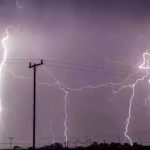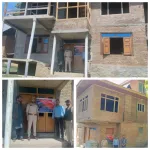Srinagar, Apr 19: Amid ongoing inclement weather, panic gripped Kashmir on Saturday afternoon after a powerful earthquake measuring 5.8 on the Richter scale jolted the region. The tremors, which struck at 12:17:53 IST, originated near the Afghanistan-Tajikistan border, sending residents rushing out of their homes in fear.
The National Center for Seismology (India) confirmed the tremor with a magnitude of 5.8, recorded at 12:17:53 IST on April 19, 2025, at latitude 36.10°N and longitude 71.20°E, with a depth of 130 km, in the Afghanistan region.
The tremors, lasting for several seconds, triggered fear and confusion in the Valley. In Srinagar and other major towns like Baramulla, Anantnag, Kupwara, Pulwama, and Ganderbal, people rushed out of their homes, shops, and offices in a state of alarm. Many were seen gathering in open areas, uncertain about aftershocks.
“It felt like the floor shifted beneath us, our windows rattled and furniture moved. Everyone just ran out,” said Shakeela Bano, a resident of Narbal Budgam.
Anees Ahmad, a local in Pattan said that the floor was shaking beneath us and the windows rattled loudly. We thought something major had happened. I was in the kitchen when everything suddenly started shaking. I grabbed my kids and ran outside. It was terrifying,” he said.
Although there were no immediate reports of injuries or structural damage, the sudden shaking led to momentary chaos, particularly in densely populated areas and multi-storey buildings. Social media was quickly flooded with posts and videos showing the impact—swinging ceiling fans, trembling walls, and residents describing the tremor as “intense but short-lived.”
Kashmir, lying in one of the most seismically active zones of the Indian subcontinent, frequently experiences such tremors due to tectonic activity along the Himalayan fault lines. Experts have continuously urged preparedness for potential high-intensity earthquakes in the region.
The deadliest earthquake in recent history struck on October 8, 2005, along the India-Pakistan border, claiming over 80,000 lives in northern Pakistan and Jammu & Kashmir.
It is situated between the Pir Panjal and Zanskar thrusts. Other northern parts of Jammu & Kashmir are also heavily faulted, with a NW-SE trending strike-slip fault running along the Zaskar and Ladakh ranges, marking the longest fault line in the region.








